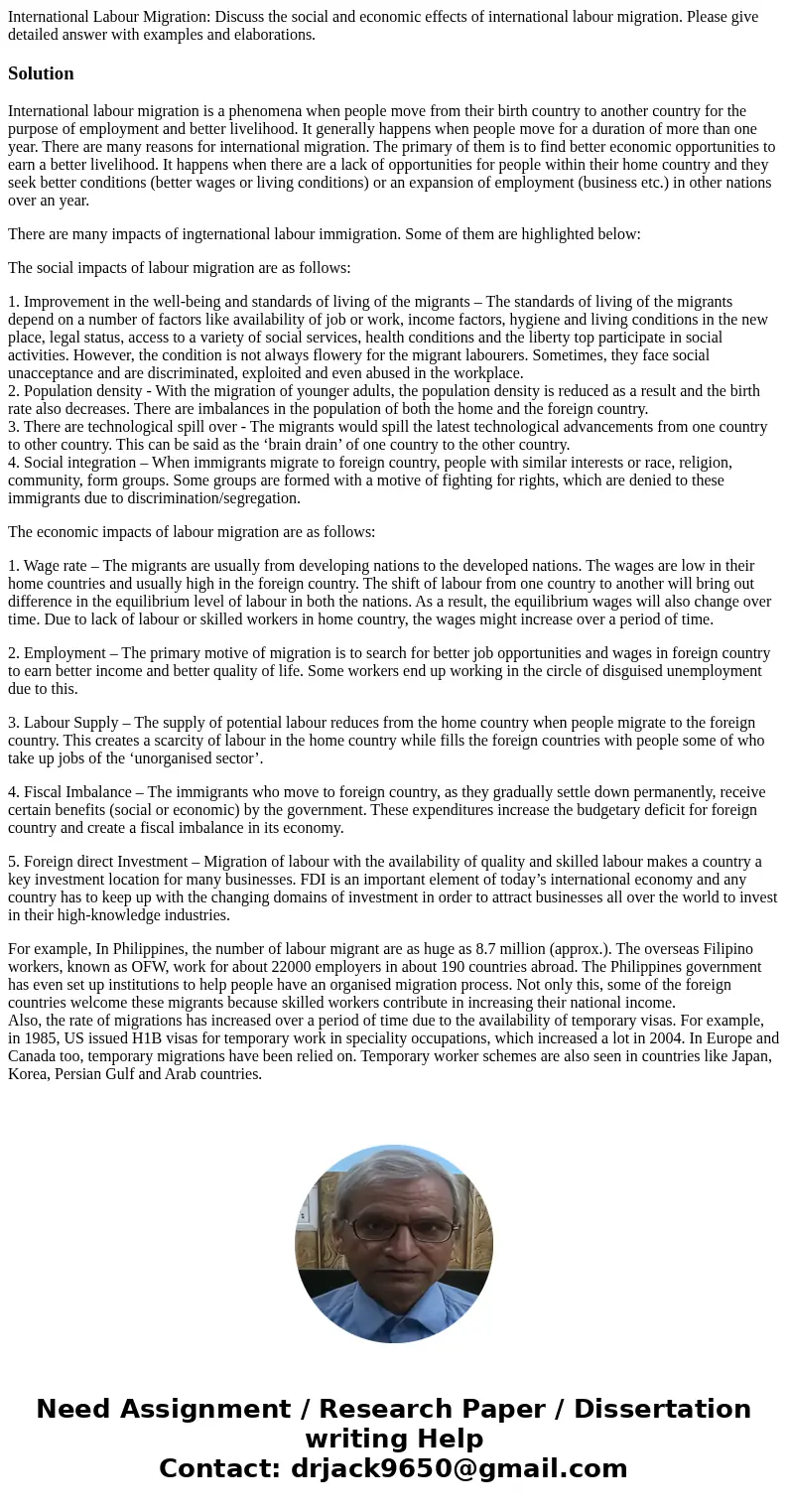International Labour Migration Discuss the social and econom
International Labour Migration: Discuss the social and economic effects of international labour migration. Please give detailed answer with examples and elaborations.
Solution
International labour migration is a phenomena when people move from their birth country to another country for the purpose of employment and better livelihood. It generally happens when people move for a duration of more than one year. There are many reasons for international migration. The primary of them is to find better economic opportunities to earn a better livelihood. It happens when there are a lack of opportunities for people within their home country and they seek better conditions (better wages or living conditions) or an expansion of employment (business etc.) in other nations over an year.
There are many impacts of ingternational labour immigration. Some of them are highlighted below:
The social impacts of labour migration are as follows:
1. Improvement in the well-being and standards of living of the migrants – The standards of living of the migrants depend on a number of factors like availability of job or work, income factors, hygiene and living conditions in the new place, legal status, access to a variety of social services, health conditions and the liberty top participate in social activities. However, the condition is not always flowery for the migrant labourers. Sometimes, they face social unacceptance and are discriminated, exploited and even abused in the workplace.
2. Population density - With the migration of younger adults, the population density is reduced as a result and the birth rate also decreases. There are imbalances in the population of both the home and the foreign country.
3. There are technological spill over - The migrants would spill the latest technological advancements from one country to other country. This can be said as the ‘brain drain’ of one country to the other country.
4. Social integration – When immigrants migrate to foreign country, people with similar interests or race, religion, community, form groups. Some groups are formed with a motive of fighting for rights, which are denied to these immigrants due to discrimination/segregation.
The economic impacts of labour migration are as follows:
1. Wage rate – The migrants are usually from developing nations to the developed nations. The wages are low in their home countries and usually high in the foreign country. The shift of labour from one country to another will bring out difference in the equilibrium level of labour in both the nations. As a result, the equilibrium wages will also change over time. Due to lack of labour or skilled workers in home country, the wages might increase over a period of time.
2. Employment – The primary motive of migration is to search for better job opportunities and wages in foreign country to earn better income and better quality of life. Some workers end up working in the circle of disguised unemployment due to this.
3. Labour Supply – The supply of potential labour reduces from the home country when people migrate to the foreign country. This creates a scarcity of labour in the home country while fills the foreign countries with people some of who take up jobs of the ‘unorganised sector’.
4. Fiscal Imbalance – The immigrants who move to foreign country, as they gradually settle down permanently, receive certain benefits (social or economic) by the government. These expenditures increase the budgetary deficit for foreign country and create a fiscal imbalance in its economy.
5. Foreign direct Investment – Migration of labour with the availability of quality and skilled labour makes a country a key investment location for many businesses. FDI is an important element of today’s international economy and any country has to keep up with the changing domains of investment in order to attract businesses all over the world to invest in their high-knowledge industries.
For example, In Philippines, the number of labour migrant are as huge as 8.7 million (approx.). The overseas Filipino workers, known as OFW, work for about 22000 employers in about 190 countries abroad. The Philippines government has even set up institutions to help people have an organised migration process. Not only this, some of the foreign countries welcome these migrants because skilled workers contribute in increasing their national income.
Also, the rate of migrations has increased over a period of time due to the availability of temporary visas. For example, in 1985, US issued H1B visas for temporary work in speciality occupations, which increased a lot in 2004. In Europe and Canada too, temporary migrations have been relied on. Temporary worker schemes are also seen in countries like Japan, Korea, Persian Gulf and Arab countries.

 Homework Sourse
Homework Sourse